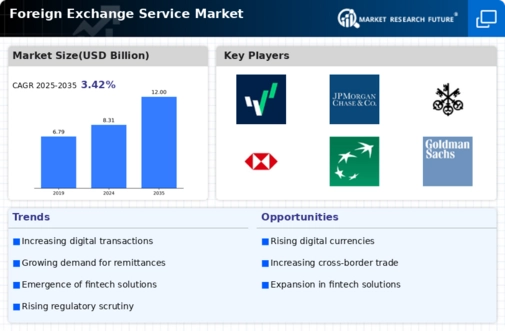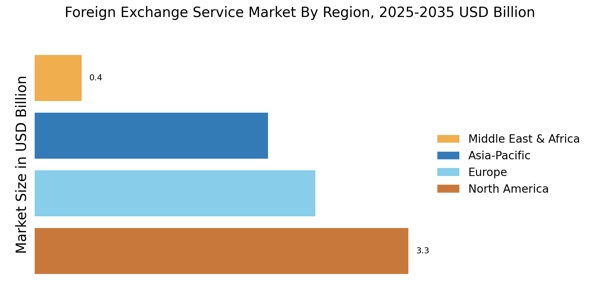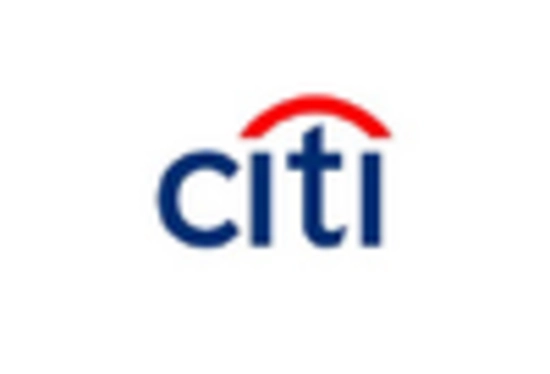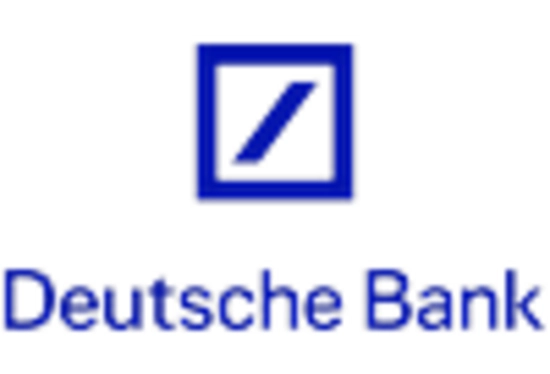The Foreign Exchange Service Market is characterized by a dynamic competitive landscape, driven by globalization, technological advancements, and the increasing need for efficient cross-border transactions. Major players such as Deutsche Bank (DE), Citigroup (US), and JPMorgan Chase (US) are at the forefront, each adopting distinct strategies to enhance their market positioning. Deutsche Bank (DE) emphasizes digital transformation, focusing on innovative trading platforms and algorithmic trading solutions to streamline operations. Citigroup (US), on the other hand, is leveraging its extensive The Foreign Exchange Service Market reach, while JPMorgan Chase (US) is investing heavily in artificial intelligence to optimize trading strategies and risk management. Collectively, these strategies contribute to a competitive environment that is increasingly shaped by technological innovation and customer-centric approaches.
In terms of business tactics, companies are increasingly localizing their operations to better serve regional markets, which appears to be a response to the growing demand for tailored financial services. The market structure is moderately fragmented, with a mix of large multinational banks and smaller specialized firms. This fragmentation allows for a diverse range of services, but the influence of key players remains substantial, as they set industry standards and drive technological advancements.
In August 2025, Deutsche Bank (DE) announced the launch of a new AI-driven trading platform aimed at enhancing real-time currency trading capabilities. This strategic move is significant as it positions the bank to capitalize on the growing demand for speed and efficiency in foreign exchange transactions, potentially attracting a broader client base seeking advanced trading solutions. The integration of AI not only streamlines operations but also enhances decision-making processes, thereby reinforcing Deutsche Bank's competitive edge.
In September 2025, Citigroup (US) expanded its foreign exchange services in Asia by forming a strategic partnership with a leading fintech firm. This collaboration is likely to enhance Citigroup's technological capabilities and improve its service offerings in a rapidly evolving market. By leveraging the fintech's innovative solutions, Citigroup aims to provide more efficient and user-friendly services, which could significantly enhance customer satisfaction and loyalty in the region.
In October 2025, JPMorgan Chase (US) unveiled a new blockchain-based platform designed to facilitate cross-border payments. This initiative is particularly noteworthy as it reflects the bank's commitment to harnessing emerging technologies to improve transaction speed and security. The adoption of blockchain technology could potentially revolutionize the foreign exchange landscape, offering clients a more transparent and efficient means of conducting international transactions.
As of October 2025, the competitive trends in the Foreign Exchange Service Market are increasingly defined by digitalization, sustainability, and the integration of artificial intelligence. Strategic alliances, such as those seen between Citigroup (US) and fintech firms, are shaping the current landscape, fostering innovation and enhancing service delivery. Looking ahead, it is anticipated that competitive differentiation will evolve, with a pronounced shift from traditional price-based competition to a focus on innovation, technological advancements, and supply chain reliability. This evolution underscores the necessity for firms to adapt and innovate continuously in order to maintain a competitive advantage in an ever-changing market.


















Leave a Comment